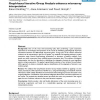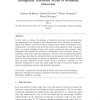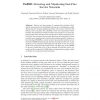70 search results - page 4 / 14 » Detecting Deceptive Groups Using Conversations and Network A... |
BMCBI
2004
13 years 8 months ago
2004
Background: One of the most time-consuming tasks after performing a gene expression experiment is the biological interpretation of the results by identifying physiologically impor...
BCB
2010
13 years 3 months ago
2010
We present a new method for identifying gene sets associated with labeled samples, where the labels can be case versus control, or genotype differences. Existing approaches to thi...
IJON
2008
13 years 8 months ago
2008
In this work we address the problem of boundary detection by combining ideas and approaches from biological and computational vision. Initially, we propose a simple and efficient ...
CIKM
2009
Springer
14 years 3 months ago
2009
Springer
The structure of customer communication network provides us a natural way to understand customers’ relationships. Traditional customer relationship management (CRM) methods focu...
DIMVA
2008
13 years 10 months ago
2008
Botnets are large groups of compromised machines (bots) used by miscreants for the most illegal activities (e.g., sending spam emails, denial-of-service attacks, phishing and other...



